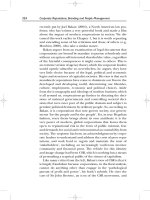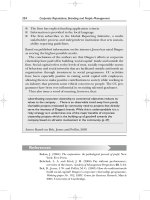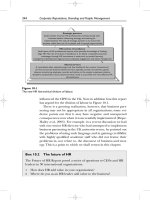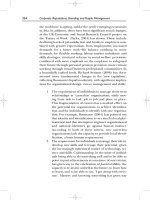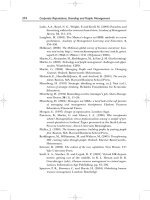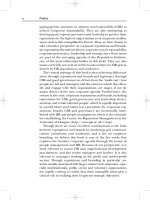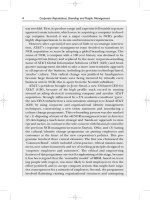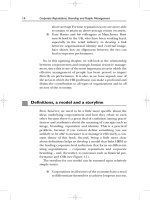Tài liệu Corporate Reputations, Branding and People Management 8 doc
Bạn đang xem bản rút gọn của tài liệu. Xem và tải ngay bản đầy đủ của tài liệu tại đây (119.93 KB, 10 trang )
of effective people management in the branding process.
In addition to the practitioner works we have cited, academics
in the branding field have been sending out relatively similar mes-
sages for a number of years (Berthon et al., 1999; Harris and
de Chernatony, 2001; Ewing et al., 2002; Buckley, 2005).
Are branding specialists on the ground taking this message
to heart? The answer, it seems, is a qualified ‘yes’. De Chernatony
(2001a, 2001b) has explored the differing interpretations held
by brand managers about branding, some of which have imme-
diate relevance for HR and people management. These inter-
pretations with some examples include:
■ brands as visual logos and signifiers, which create dif-
ferentiation in the minds of customers, e.g. the Nike
swoosh logo, Adidas’s three stripes
■ brands as legally enforceable statements of ownership,
e.g. among the ancient or prestige universities such as
Cambridge, Oxford and Harvard
■ brands as a form of shorthand for consumers, e.g.
Hoover or McDonald’s, which:
❐ assist the information processing limitations of
individuals and help them to make attributions
about products and services
❐ reduce the risk for customers in imperfect
markets
■ brands as positioning by helping associate brands with
particular benefits for customers, e.g. the Virgin brand
and Virgin Blue in Australia, Rolex
■ brands as personality, in which brands are infused with
emotional values beyond their functional benefits, e.g.
Coke helping the world to come together, Calvin Klein
underwear
■ brands as a relationship builder, which is an extension
of the idea of brands as embodying a personality into
the notion of customers having a relationship with the
brand, e.g. Disney, British Airways
■ brands as clusters of values, which help organizations
extend into new markets with related values, e.g. Virgin
and its moves into the soft drinks market, Sony and its
moves into entertainment
54 Corporate Reputations, Branding and People Management
■ brands as added value beyond the basic product or
service offering, for which customers value and are
usually willing to pay a premium price, e.g. Kellogg’s,
Colgate, Unilever’s soap powders
■ brands as visions, which are mainly used to galvanize
stakeholders into actions designed to attain some future
desired state, e.g. Sony’s pioneer brand offering innov-
ation, British Airways and the ‘world’s favourite airline’
culture change programme, Audi’s ‘Vorsprung Durch
Technik’ (advance with technology) strapline, political
parties such as the re-branding of ‘New Labour’ in the
UK during the 1990s
■ brands as identity that set out an ethos with which
organizational stakeholders can readily associate, e.g.
the Body Shop, Apple, Ben & Jerry, Hewlett-Packard,
Cancer Research
■ brands as image, which focuses on what customers per-
ceive to be real, e.g. Barbie, Harry Potter, Evian and
BMW
■ branding companies, which reduce the needs to pro-
mote individual lines of business or products, and are
increasingly seen as a way of engaging new and exist-
ing employees in the corporate brand, the key focus of
this book.
You should be able to see from these diverse interpretations
that the brand managers in this study viewed branding not only
as playing a key external role in adapting their organizations to
market circumstances, but also in aligning people behind the
brand. In Figure 2.2 we have adapted de Chernatony’s (2001a,
2001b) ideas to construct a representation of the internal and
external views on branding.
Of the 12 roles of branding identified above, at least three
are strongly internally focused and have major implications for
people management and HR professionals. It should also be
noted that there is a ‘clear line of sight’ between people man-
agement, the employee-focused definitions of branding and
the externally focused definitions. So, for example, in one of
the cases we researched for this book, Agilent Technologies
(an off-shoot of Hewlett-Packard), senior HR managers were
Chapter 2 Managing corporate brands and reputations 55
unable to make a distinction between the notion of branding
as identity and branding as a cluster of values, seeing instead a
strong interpenetration between the two concepts. Given Hewlett-
Packard’s long history as an employee-oriented brand, this
should not be surprising. Similarly, one might expect the same
degree of interpenetration between brands as visions and cor-
porate branding, as we shall argue later in this text.
This marketing and branding literature, however, is to be
treated with a little caution as we have already noted in our
point about its ideological basis. There is little doubt that it is
stronger on prescription and on how things should be than on
description of how things are. For example, to argue that brands
56 Corporate Reputations, Branding and People Management
Branding as
logos and
signifiers
Branding as
values
Branding as
corporations
Branding as
shorthand
Branding as
personality
Branding as
ownership
Branding as
added value
Branding as
image
Branding as
positioning
Branding as a
relationship
builder
Branding as
vision
People
management
Branding as
identity
Figure 2.2
Interpretations of branding and the links with HR (based on
de Chernatony, 2001; Martin and Beaumont, 2003).
should be at the heart of all key decisions in an organization is
inconsistent with how many successful organizations operate in
practice. Moreover, as we have seen, consumers are increasingly
wary of the negative connotations of brands and the ‘spin’ asso-
ciated with brand managers, public relations and communica-
tions departments. Most branding and marketing literature is
underpinned by a unitary, communications perspective which
is based on an assumption that organizations are essentially
conflict-free and made up of homogeneous cultures. If they are
not, the argument goes, they should be made so through effect-
ive communications. From this perspective, conflict, politics and
sub-cultures are seen as unnatural, malfunctions of naturally
ordered systems, to be treated by having consumers, employees
and other stakeholders understand the truth of where their true
interests lie. As a result, this branding literature, just like the
dramatized accounts of celebrity firms we discussed in the open-
ing chapter, tends to restrict the role of HR to communicating
brand values downwards, rather than as being the source of such
values and the driver of key aspects of strategy. As many of us
schooled in the university of life will be aware, however, commu-
nications will only get us so far; not everyone has the same
interests, nor are organizations necessarily better off without a
legitimate expression of conflict over competing interests, since
it is usually only through conflict and speaking up to power that
often-needed change results. Indeed, it is incumbent on good
followers to express legitimate concerns. We will deal with this
aspect of leadership and governance in Chapter 9.
Harris and de Chernatony’s (2001) model, though strong in
some respects, illustrates these criticisms quite well. The start-
ing point for these authors is the need for employees to become
‘brand ambassadors’ in their role as the key interface between
the internal and external environment of the organization and
in having a potentially powerful influence on customers’ per-
ceptions of the brand offering and the corporation. Nevertheless,
we should not ‘throw the baby out with the bathwater’. They make
a useful attempt at bringing together a number of the previ-
ously discussed different interpretations of brands to explain
the concept of brand identity, defined by them as ‘an organiza-
tion’s ethos, aims and values that create a sense of individuality
which differentiates a brand’ (p. 442). From Figure 2.3 we can
Chapter 2 Managing corporate brands and reputations 57
see that brand identity comprises the connections between its
core vision and culture, the company’s positioning in the mar-
ketplace, the emotional or personality characteristics of poten-
tial customers with which it wishes to associate, its presentation
styles and, finally, the consistency between employee relation-
ships and customers.
They further argue that a brand’s identity is not always the
same as its reputation, which they define as ‘a collective reputa-
tion of a brand’s past actions and results’ (p. 445) that describes
its ability to deliver value to key stakeholders. These authors
regard brand reputation as more important in establishing and
measuring brand performance, precisely because reputation
takes into account the past as well as the present and it also
encompasses all organizational stakeholders.
58 Corporate Reputations, Branding and People Management
Brand vision
and culture
Relationships
between staff and
customers
Positioning Personality
Brand
presentation
Brand identity
Brand
reputation
Figure 2.3
The relationships between brand identity and brand reputation (based
on Harris and de Chernatony, 2001, p. 443).
